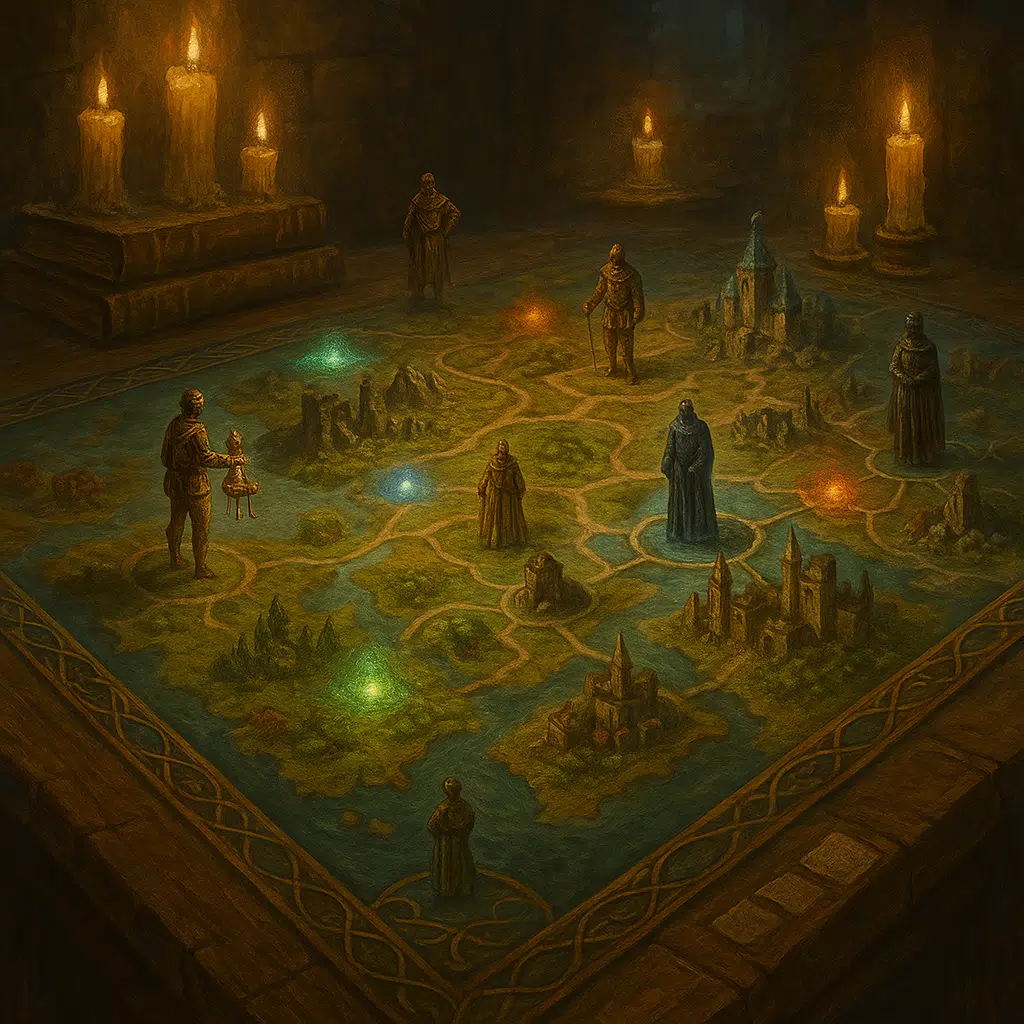Estimated Reading Time: 24 minutes (4489 words)
The moment a player reaches for the controller, they enter into an unspoken contract with the game’s creators. In exchange for their time and engagement, they expect both the freedom to express their will and the satisfaction of a well-crafted story. This tension — between the player’s desire to act and the developer’s desire to tell — stands at the emotional center of interactive storytelling.
Games that master this balance create experiences that resonate far beyond their playtime. Think of your own gaming memories: they likely revolve around moments when your choices felt consequential within a narrative framework that gave them meaning. The Walking Dead’s heartbreaking decisions. Mass Effect’s character relationships that spanned an epic trilogy. Outer Wilds’ player-driven discoveries that slowly unveil cosmic mysteries.
The most compelling interactive experiences aren’t those that maximize either freedom or narrative control, but those that understand the psychology of agency — how players perceive their impact on the world, how they construct personal stories from their experiences, and how they emotionally connect to the consequences of their actions.
This delicate dance between player agency and narrative structure isn’t just a technical problem to solve, but an artistic pursuit that requires understanding both the mechanics of game systems and the nuances of human psychology. When we look beyond surface-level design patterns, we discover that creating meaningful player agency requires much more than simply offering choices.
The delicate balance between player agency and narrative structure forms the core of engaging game experiences. When executed well, players feel both empowered by their choices and moved by a cohesive story. Striking this balance requires understanding both game mechanics and human psychology.
- Design choices with meaningful consequences: Players can sense when their decisions matter. Create branching paths with substantial differences rather than superficial variations to make agency feel authentic and rewarding.
- Leverage environmental storytelling: Not all narrative needs to halt gameplay. Environmental cues, artifacts, and atmosphere can deliver story without removing control, allowing players to absorb narrative at their own pace while maintaining agency.
- Create emotional anchors through character relationships: When players form attachments to NPCs, their choices gain emotional weight. These relationships transform abstract game decisions into meaningful personal narratives that players genuinely care about.
- Consider different player types in your design: Some players crave exploration freedom while others prefer narrative guidance. Design systems with multiple parallel agency mechanisms to accommodate various play styles rather than forcing all players into one mode of interaction.
- Prioritize consistent reaction systems: Agency feels hollow without consistent responses to player actions. Develop robust systems where the game world acknowledges and responds to player behavior across multiple dimensions.
- Balance player freedom with narrative guardrails: Rather than offering unlimited choices or rigid storylines, create narrative funnels that guide players toward key story moments while allowing meaningful expression within those boundaries.
- Test perception, not just mechanics: How players perceive their agency often matters more than technical implementation. Regularly test whether players feel their choices matter, not just whether the branching logic works.
Balancing player agency and narrative isn’t just a technical challenge—it’s an art form that requires understanding human psychology, storytelling fundamentals, and game design principles. Let’s explore how to master this delicate dance.

The Psychology Behind Player Agency
Why we crave control in virtual worlds
Human beings have an innate desire for autonomy. This psychological need runs deep—we want to feel that our actions matter and that we can influence our surroundings. In virtual worlds, this desire intensifies. Players step into digital environments precisely because these spaces promise something often lacking in real life: clear cause and effect relationships where our choices visibly shape outcomes.
Game worlds offer a controlled environment where agency can be exercised without real-world consequences. The ability to make decisions, see their results immediately, and retry if desired creates a psychological safety net that encourages experimentation. This freedom to act without permanent repercussions satisfies our natural curiosity while providing the satisfaction of mastery and control.
Research in self-determination theory supports that autonomy is one of three fundamental psychological needs driving intrinsic motivation. When a game constrains player choice too severely, it triggers what psychologists call “psychological reactance”—the uncomfortable feeling that our freedom is being restricted, often resulting in dissatisfaction or even abandonment of the experience. This explains why on-rails sequences and excessive cutscenes frequently receive negative player feedback; they temporarily strip away that sense of control players enter the virtual world to experience.
The emotional foundations of meaningful choice
Choice becomes meaningful when it connects to players’ emotional frameworks. The decisions that resonate most powerfully tap into fundamental human concerns: morality, identity, relationships, and personal values. When a game asks players to choose between saving one character or another, it’s not merely testing strategic thinking—it’s provoking emotional investment and self-reflection.
The anticipation before making a significant decision creates emotional tension, while the aftermath—seeing consequences unfold—produces emotional resolution or complication. This emotional journey forms the core of player engagement with narrative. Meaningful choices must be comprehensible (players understand what they’re choosing between), consequential (the choice changes something important), and connected to values the player cares about.
Players also experience what psychologists call “cognitive ownership” over decisions they make. When we actively choose a path rather than having it chosen for us, we become more invested in the outcome—even defending choices that yield suboptimal results. This phenomenon explains why player-driven narratives often generate stronger emotional responses than predetermined storylines, regardless of the actual content quality. We care more about stories we help create than those merely presented to us.
When Choices Matter: Designing Consequential Decisions
Beyond cosmetic changes: Creating substantive branching
Truly consequential choices alter fundamental aspects of the game experience. They change not just what players see, but what they can do, who they can interact with, and which challenges they face. Substantive branching requires divergent storylines, alternate environments, different character interactions, and varied gameplay challenges—all expensive and time-consuming to create, which explains their relative rarity.
The most effective branching designs focus resources on pivotal moments rather than attempting to branch at every decision point. These key junctures—what game designers call “tentpole moments”—serve as major narrative intersections where player choice dramatically shifts the experience. Between these moments, smaller choices can create personalization and texture without requiring completely separate content tracks.
Consequential choices should ideally affect multiple dimensions of the game experience. A single decision might simultaneously impact the narrative direction, alter NPC relationships, change available resources, open or close certain spaces, and modify gameplay challenges. This multidimensional approach creates the impression of a responsive world while maximizing the impact of each branching point. When The Witcher 3 asks players whether to help a spirit trapped in a tree, the decision affects an entire region’s fate, multiple characters’ lives, and even which quests become available later—demonstrating how a single choice can ripple through many systems.
The illusion of choice vs. actual agency
The “illusion of choice” has become a contentious term in game design. At its worst, it represents cynical manipulation—presenting players with decisions that ultimately lead to identical outcomes. At its best, it’s a necessary design technique that focuses development resources on creating emotionally resonant moments rather than exponentially multiplying content.
Players can detect false choices with surprising accuracy. When identical dialogue follows different responses, or when narrative paths reconverge too quickly and obviously, the experience feels cheapened. However, when choices affect how events unfold rather than what events unfold, players often perceive meaningful agency even when the destination remains fixed. The journey matters as much as the destination.
The most sophisticated approach isn’t choosing between “real” branching and “fake” choices, but creating a spectrum of consequence. Some decisions might alter the entire game trajectory, while others change character relationships, modify specific scenes, or simply express the player-character’s personality without changing external events. This layered approach creates depth without requiring infinite content. What matters is not whether every choice changes everything, but whether players feel their decisions have appropriate impact within the story’s context.

Environmental Storytelling as Agency Enhancer
Letting players discover narrative at their own pace
Environmental storytelling represents a perfect marriage between player agency and narrative intent. By embedding story elements within the game world itself—through architecture, artifacts, ambient sounds, and spatial relationships—designers create narratives players can engage with at their own pace and in their own order. This approach respects player autonomy while still delivering rich narrative content.
Dark Souls exemplifies this approach, telling much of its story through item descriptions, environmental details, and enemy placements. Players who wish to understand the world can piece together its history and mythology by exploring thoroughly, while those primarily interested in combat challenges can still progress with minimal narrative engagement. This layering allows different player types to extract the experience they seek from the same content.
The power of environmental storytelling lies in its invitation to active interpretation rather than passive consumption. When players encounter a dining hall with half-eaten food, overturned furniture, and evidence of violence, they naturally begin constructing narratives about what happened. This mental process involves them as co-creators rather than mere recipients, deepening engagement and ownership of the experience. The most effective environmental storytelling provides enough clues to suggest narrative directions without forcing a single interpretation.
Worldbuilding through exploration and observation
When worldbuilding elements are embedded in explorable environments rather than delivered through exposition, players experience the satisfaction of discovery. Finding a hidden journal, overhearing a conversation between NPCs, or noticing architectural details that reveal cultural values—these moments reward curiosity and attention, making players active participants in uncovering the world’s depth.
The most sophisticated implementations create interconnected storytelling ecosystems, where discoveries in one location provide context for observations in another. Bioshock’s Rapture tells its story through audio logs, environmental scenes, and architectural designs that collectively reveal the city’s rise and fall. Players who thoroughly explore understand the tragedy more deeply, but even casual observation provides enough context to make the world feel coherent.
This approach also accommodates different play styles. Methodical players who examine every corner are rewarded with richer narrative understanding, while those who prefer faster progression still encounter enough worldbuilding elements to grasp the essential context. By distributing narrative across environments rather than concentrating it in non-interactive sequences, designers respect player agency while still delivering their intended story. This balance represents one of the most elegant solutions to the agency-narrative tension.
The Power of Character Relationships
How NPC connections transform abstract choices into personal stories
Character relationships transform abstract moral choices into emotionally resonant decisions. When players develop connections with virtual characters, decisions affecting those characters carry emotional weight far exceeding their mechanical impact. Choosing between two gameplay advantages feels fundamentally different from choosing between helping two characters with whom the player has established relationships.
These relationships create emotional anchors within the game world. Players might forget plot details or mission objectives, but they remember how they felt about Garrus in Mass Effect or Arthur Morgan’s journey in Red Dead Redemption 2. These character connections become the emotional architecture supporting player investment in the broader narrative. When major decisions involve characters players care about, those decisions become memorable moments that define the play experience.
Character-driven choices also naturally encourage role-playing and self-expression. Players consider not just optimal outcomes but what their version of the protagonist would do in a given situation. This identification deepens engagement with the narrative and transforms prescribed story beats into personal experiences. The most effective narrative designs recognize that players often make choices based on relationship preservation or development rather than mechanical advantage or even moral alignment.
Building attachment systems that respond to player behavior
Sophisticated relationship systems respond dynamically to how players interact with characters over time. Rather than offering binary “friend or foe” states, these systems track multiple variables: trust, respect, intimacy, fear, or admiration. This nuance allows for complex relationships that evolve naturally through gameplay rather than through prescribed dialogue choices alone.
Dragon Age: Inquisition’s companion approval system exemplifies this approach, tracking not just whether companions like the player-character but on what basis that approval rests. Companions respond differently to various player actions based on their own values and personality, creating a network of relationships that reflects genuine social dynamics rather than simple meters to be maximized.
These systems become most compelling when they incorporate believable friction. Characters who sometimes disagree with player choices but remain loyal for established reasons feel more authentic than those who either agree with everything or immediately abandon the relationship over a single disagreement. This complexity allows relationships to weather conflicts, creating narratively interesting tension without artificial harmony or premature termination of important character connections.

Designing for Different Player Motivations
Agency through exploration vs. narrative progression
Players seek different forms of agency depending on their motivations. Exploration-oriented players define agency through freedom of movement and discovery. For these players, open worlds with minimal gating provide the strongest sense of agency, even if the central narrative remains relatively linear. Their satisfaction comes from setting personal goals—reaching distant landmarks, finding hidden areas, or completing collection challenges at their own pace.
Narrative-focused players, conversely, define agency through story influence. They may happily accept more constrained environments if those limitations support more responsive storytelling with meaningful branches and personalized character development. For these players, a smaller space with more interactive narrative elements provides stronger agency than vast but narratively static landscapes.
The most successful designs acknowledge these different player types by creating multiple parallel agency systems. Horizon Zero Dawn offers a compelling central narrative with some key player choices, while simultaneously providing vast explorable territories with discovery-based storytelling. This layered approach allows different player types to engage with the content that provides their preferred form of agency, without feeling that other elements diminish their experience.
Multiple parallel pathways for different player types
Beyond the exploration-narrative spectrum, players seek agency through different gameplay systems: combat mastery, character customization, social simulation, creative building, or strategic management. By developing multiple systems through which players can express agency, games can appeal to diverse player motivations without diluting their core identity.
Stardew Valley exemplifies this approach by offering parallel progression tracks: farming, mining, fishing, combat, crafting, and social relationships. Players can emphasize whichever aspects most appeal to them while still experiencing a coherent game. This design recognizes that player agency isn’t one-dimensional but manifests differently based on individual preferences.
These parallel systems also provide natural pacing variation. When players encounter difficulty or saturation in one system, they can temporarily shift focus to another, preventing frustration while maintaining engagement with the broader experience. This approach transforms what might be breaking points into pivot points, keeping players within the game’s ecosystem even when specific challenges become temporarily less appealing.
Creating Consistent Reaction Systems
Why the world must acknowledge player actions
Inconsistent reactions to player actions create cognitive dissonance that undermines the sense of agency. When a game acknowledges a player’s choice in one instance but ignores similar actions elsewhere, the world feels less responsive and more artificial. This inconsistency reminds players they’re experiencing a constructed system with limitations rather than an authentic world that responds to their presence.
The most compelling virtual worlds maintain consistent reaction frameworks across different scales of player action. From small environmental interactions (objects breaking, liquids spilling, surfaces marking) to medium-scale systemic responses (NPCs reacting to player appearance or behavior) to large narrative consequences (factions changing disposition, environments transforming), these reaction systems create a sense that player presence matters at every level of engagement.
Red Dead Redemption 2 exemplifies this approach with systems that track mud on clothing, NPCs who remember past interactions, and environments that change permanently based on story progression. This consistency across micro and macro reactions creates a world that feels responsive rather than merely reactive at prescribed moments, deepening the player’s sense of existing within a coherent reality rather than moving through a sequence of scripted scenarios.
Designing feedback loops that reinforce agency
Effective reaction systems create feedback loops that encourage further player action. When the world consistently responds to player behavior, players naturally experiment more, testing the boundaries of the system and discovering new interaction possibilities. This exploration creates a virtuous cycle where player curiosity leads to discovery, which reinforces the sense of agency, which in turn stimulates more curiosity.
These feedback loops operate most effectively when they connect across systems rather than remaining isolated within them. When combat choices affect NPC relationships, which influence economic opportunities, which unlock exploration options, which reveal narrative content—these interconnected consequences create a sense of a living world where actions have cascading effects rather than contained outcomes.
The most sophisticated designs incorporate both immediate feedback and delayed consequences. Immediate reactions provide clear causality that reinforces the player’s sense of impact, while delayed consequences create the impression of a world that remembers and evolves in response to player behavior over time. This temporal layering makes the world feel not just responsive but persistent, with a memory that extends beyond the current play session.

The Art of Narrative Funneling
Guiding without controlling
Narrative funneling—guiding players toward key story moments while preserving their sense of agency—represents perhaps the most delicate challenge in narrative game design. The most elegant funneling feels like a natural convergence of player-driven paths rather than an artificial narrowing of options. This requires anticipating likely player motivations and aligning them with narrative necessities.
Effective funneling often employs layered motivational strategies. The same destination might be reached through curiosity, character attachment, strategic advantage, and moral imperative—allowing different player types to follow their own motivations toward a necessary narrative juncture. This approach respects player psychology while serving structural needs.
The pacing and visibility of funneling also significantly impact player perception. Gradual narrowing with multiple intermediate choice points feels more respectful of agency than sudden constriction. Similarly, transparent funneling—where players understand why certain paths converge—generates less resistance than funneling that attempts to disguise its purpose but fails, creating the sensation of being manipulated rather than guided.
Setting boundaries that feel like opportunities
The most sophisticated boundary designs transform limitations into opportunities by reframing constraints as enabling conditions. Rather than simply blocking paths with invisible walls or contrived obstacles, thoughtful designs make boundaries feel like natural features of the world that create interesting possibilities rather than merely preventing unwanted player movement.
Prey (2017) exemplifies this approach with its space station setting. The station’s sealed nature creates natural boundaries, but these limitations enable rich systemic gameplay involving environmental manipulation, zero-gravity navigation, and alternate pathways that would be impossible in a more open setting. The constraints become fundamental to the experience rather than restrictions upon it.
Narrative boundaries function similarly when well-designed. A character’s professional obligations, personal commitments, or physical limitations can create narrative guardrails that feel authentic to the world and character rather than arbitrary restrictions imposed by developers. When these boundaries align with the established fiction, players accept them as part of role-playing the protagonist rather than limitations on their own agency.

The Gap Between Mechanical and Perceived Agency
Why player perception trumps technical implementation
The technical implementation of choice systems matters far less than how players perceive their agency. Games with relatively simple branching structures can create powerful impressions of agency through effective framing, emotional resonance, and appropriate feedback. Conversely, systems with more complex backend implementation can feel restrictive if poorly presented or insufficiently responsive to player expectations.
Telltale’s The Walking Dead series demonstrates how perceived agency can exceed mechanical reality. Despite relatively limited branching, players reported strong feelings of responsibility and agency because choices were emotionally charged, consequences were clearly attributed to player decisions, and the game consistently acknowledged past choices through dialogue and visual cues. The impression of agency was strengthened through psychological techniques rather than extensive technical branching.
This gap between implementation and perception shouldn’t be viewed as license for deception, but as recognition that agency is ultimately a psychological experience rather than a technical feature. The goal isn’t to trick players but to understand what creates the authentic feeling of making meaningful choices within a responsive world, then designing systems that deliver this experience efficiently.
Testing emotional responses, not just systems
Testing choice-based games requires evaluating emotional impact alongside technical functionality. Traditional QA focuses on whether systems work as intended, but agency testing must address subjective questions: Do players feel their choices matter? Are they emotionally invested in decisions? Do they perceive appropriate consequences for their actions?
These questions require different testing methodologies than traditional QA. Observational playtests, emotional response tracking, narrative comprehension assessment, and longitudinal studies of how players reflect on their choices after completing the game provide more relevant data than simple bug detection or progression tracking. The key metrics become emotional engagement, perceived significance of choices, and long-term memory formation rather than completion rates or technical stability.
The most valuable feedback often comes from players comparing their experiences with others who made different choices. When players discover that their experience differed meaningfully from others based on their decisions, it retroactively strengthens their perception of agency. This social dimension of choice validation explains why community discussions often become integral to player appreciation of choice-based narratives, suggesting that designing for post-play comparison can enhance perceived agency.
Emotional Weight as the True Measure of Agency
How stakes create meaningful decision moments
Emotional stakes transform mechanical choices into memorable decisions. When players care deeply about potential outcomes, even relatively simple binary choices can create powerful experiences of agency. These stakes arise from various sources: character attachments, moral values, identity investment in the protagonist, or anticipated consequences for the game world.
The most resonant stakes connect to universal human concerns while remaining specific to the game’s context. Life-or-death decisions for characters players have grown to care about, moral dilemmas without clean solutions, choices between competing values that cannot be simultaneously satisfied—these situations create genuine emotional conflict rather than mere tactical calculation. When players struggle with decisions not because they’re uncertain which option is “better” but because each option reflects different values or priorities, the choice becomes an act of self-expression.
Time pressure intensifies emotional stakes by preventing analytical detachment. When decisions must be made quickly, players rely more on emotional responses and personal values than calculated advantage. This constraint often makes choices feel more authentic and consequential, as they reveal immediate priorities rather than carefully reasoned strategies. Games like Until Dawn use time-limited choices specifically to create this pressure, forcing players to react instinctively in ways that reveal character priorities.
Designing choices players will remember years later
The most successful choice designs create what psychologists call “flashbulb memories”—vivid, emotionally charged recollections that persist long after other details have faded. These memorable moments typically share key characteristics: clear personal agency (the player clearly caused what happened), emotional significance (the outcome mattered to the player), and narrative distinctiveness (the moment stands out from routine gameplay).
Unexpected consequences can create these durable memories, particularly when they reveal unintended implications of choices made with incomplete information. The infamous “twists” in games like Spec Ops: The Line or Bioshock work precisely because they recontextualize player actions, creating retrospective emotional impact that lingers long after the game ends.
Shared cultural touchpoints often emerge from these memorable choices. Years after release, players of Mass Effect still discuss the Virmire decision, The Witcher 3 players debate the Bloody Baron questline outcomes, and The Walking Dead players remember their choices regarding Clementine. These persistent conversations demonstrate how emotionally weighted choices become part of gaming culture, referenced and discussed long after technical innovations or visual achievements have been surpassed.
Case Studies in Balanced Design
Games that succeeded in the agency-narrative dance
The Last of Us Part II achieves narrative cohesion without sacrificing player agency by focusing emotional impact through controlled perspective shifts rather than branching paths. By forcing players to experience different viewpoints within a largely predetermined narrative, it creates powerful emotional agency—the freedom to form and revise moral judgments—even while providing limited structural choice. This approach demonstrates that agency can exist in how players interpret events, not just in determining those events.
Disco Elysium creates extraordinary depth of character expression within a relatively fixed narrative framework. While most major plot points remain consistent, the protagonist’s personality, political beliefs, psychological approach, and interpersonal style can vary dramatically based on player choices. This character-focused agency creates the impression of a highly responsive world because the lens through which that world is perceived and interpreted changes so significantly based on player decisions.
Outer Wilds achieves perfect harmony between player agency and narrative by making discovery itself the story. Its time-loop structure allows complete exploration freedom while maintaining narrative coherence, as players piece together understanding at their own pace and in their own order. The narrative never wrests control from players because advancing the story requires active investigation rather than triggered sequences. This design demonstrates how exploration and narrative can become inseparable rather than competing elements.
Learning from notable failures and player reactions
Mass Effect 3’s ending controversy offers crucial lessons about expectation management in choice-based narratives. After two games that emphasized player choice and consequence, the relatively homogeneous endings created fierce backlash not because they were inherently poor, but because they failed to fulfill the promise of meaningful differentiation based on prior decisions. This reaction demonstrates how agency expectations, once established, create a contract with players that must be fulfilled or deliberately, transparently renegotiated.
No Man’s Sky’s initial reception reveals the dangers of overpromising agency without delivering corresponding systems. Early marketing suggested near-infinite meaningful variation and discovery, but at launch, the game lacked sufficient systems to make exploration consistently rewarding. Though subsequent updates dramatically improved these systems, the initial disconnect between promised and delivered agency created significant player disappointment. This case study highlights how agency must be supported by robust systems that make freedom meaningful rather than merely extensive.
Fallout 4 demonstrates the challenges of balancing role-playing agency with voiced protagonists and simplified dialogue systems. The shift from multiple detailed dialogue options to a four-direction system with abbreviated previews reduced players’ ability to express specific character perspectives, creating tension with the series’ role-playing heritage. The subsequent return to more detailed dialogue options in later Fallout entries acknowledges this tension, showing how developers can learn from player feedback about agency restrictions.
The beauty of interactive storytelling lies in its fundamental promise—not that we can do anything, but that what we choose to do matters. When designers honor this promise, games become more than entertainment; they transform into mirrors reflecting our values, testing grounds for our moral intuitions, and spaces where we practice the art of living with consequences. Perhaps this is why we remember certain gaming moments years later, not just for their spectacle, but for how they made us feel: powerful yet vulnerable, free yet connected to something larger than ourselves. In this space between control and surrender, between agency and narrative, games find their unique voice among all artistic mediums.






